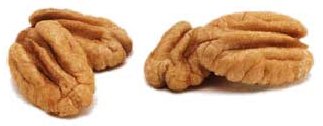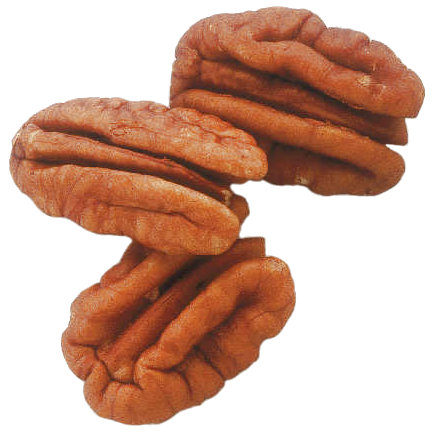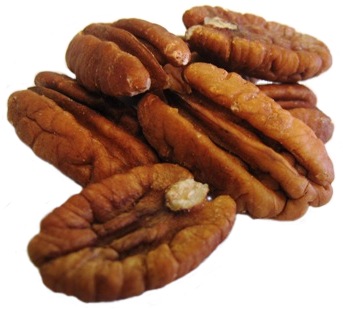

Pecans

Carya. (From Greek karya, a nut-bearing tree.) HICKORY; PECAN. Juglandaceae. Around 25 species of large trees, deciduous, monoecious; pith solid. Branches brown to grey, smooth, becoming scaly. Leaves alternate, odd-pinnate, exstipulate; leaflets 3-17, opposite, serrate. Male inflorescence a penulous, three-branched catkin; calyx 2-3 lobed; stamens 3-10; female inflorescence a terminal spike, 2-20-flowered, perianth absent, involucre 4-lobed; ovary unilocular. Fruit a drupe, globular to ovoid, indehiscent, husk thick, green, separating into 4 valves; nut smooth or angled, imcompletely 2-4-celled, occasonally winged. E US, C and SE China. CultivationCarya species make aesthetic specimen and shade trees, with tall, straight boles and rounded to conical crowns of pinnate foliage that becomes rusty red, orange-green and clear yellow in the autumn. Carya ovata and Carya tomentosa are regarded to have the best autumn colouring. Carya illinoensis (pecan) and Carya ovata (shagbark hickory) provide the most important commercial nut crops: choice cultivars are good croppers in the southern states of the US. The pecan is the largest and fastest-growing in a generally slow-growing genus. Like Carya aquatica, it will not survive temperatures below about -12ºC. The pecan crops poorly at the northerly limit of its range since it requires long warm summers and mild winters to ripen nuts. Most species prefer deep, moist, humus-rich loams approximating to the conditions afforded by the sheltered, wooded valleys in which they naturally occur, but Carya glabra, Carya ovata and Carya tomentosa thrive on drier soils. Carya aquatica is found in wet places. propagate from seed sown ripe or stratified over winter for spring sowing. Move seedlings on rapidly from nursery beds to final positions as transplanting is difficult due to a long taproot; seed may be best sown in situ. propagate cultivars of good nut-producers by splice or veneer grafting on to Carya cordiformis in the greenhouse in spring. Susceptible to leaf spot diseases, powdery mildew and crown gall (Agrobacterium radiobacter variety tumefaciens). Galls, although unsightly, are unlikely to cause serious damage. The most common insect pests are gall aphid, bark beetle, cigar casebearer, twig-girdler, borers, June beetle, caterpillars and scale. Carya aquaticaBITTER PECAN; WATER HICKORY. To 20m. Bark light brown, peeling. Leaflets to 11cm, 7-13, lanceolate, acuminate, yellow-tomentose when young. Fruit ovate, to 4cm; nut obovoid, compressed, 4-angled, rust-brown, astringent. SE US (Florida to Texas). Z6.  Carya catheyensis
Carya catheyensis
CHINESE HICKORY. To 20m. Young branches with orange-yellow scales. Leaflets to 14cm, ovate to ovate-lanceolate, green above, yellow-green below; midrib pubescent. Fruit 4-winged, to 25cm; nut ovoid, slightly angled. C and S China. Z6. Carya cordiformisBITTERNUT; SWAMP HICKORY. To 28m. Bark light grey, rarely scaly, young branches rust-red, puberulent, later glabrous; buds bright yellow. Leaflets 7-13cm, 5-9, ovate-lanceolate, acuminate, light green, pubescent, later galbrous, veins pubescent beneath. Fruit suborbicular, to 3cm, 4-winged; nut grey, almost smooth, thin-shelled, acuminate. NE US. Z4. Carya glabraPIGNUT; SMALL-FRUITED HICKORY; BROOM HICKORY. To 30m, occasionally more. Bark grey, narrowly furrowed. Leaves 18-27cm; leaflets to 15cm, 3-7, terminal leaflet obovate, lower pair ovate-lanceolate, shorter. Fruit obovate-globose, about 2cm, splitting to middle; nut brown, astringent. E US. variety megacarpa. COAST PIGNUT HICKORY. Fruit 3-5cm, obovoid, slightly compressed. Z4. Carya illinoensisPECAN. To 50m, usually much less. Buds yellow in winter, scales 4-6. Leaflets 11-17, short-stalked, oblong-lanceolate, acuminate, 9-15cm, usually glabrous. Fruit in terminal spikes, 3-8cm; nut oblong, brown, thin-shelled, acuminate. Iowa and Indiana south to Texas and Mexico. (a) Eastern Pecans: grown in humid southeastern states (Louisiana to Florida), generally less prone to scab and foliage diseases than those of western origin, but will also grow well in western regions. ‘Choctaw’: mid-season; prcocious, protogynous; nut medium-large, very thin-shelled, excellent flavour. ‘Desirable’: mid-season; precocious, protandrous; nuts large, good flavour and quality; good scab resistance. ‘Forkert’: late season; precocious, protogynous; nuts large; good scab resistance; good for coastal plantings. ‘Hastings’: mid-season; hardy; protogynous; nuts fairly thin-shelled, good quality; scab tolerant; compatible for pollination with ‘Desirable’. ‘Mahan’: late; prolific, protogynous; nuts vary large, thin-shelled, excellent flavour; fruit quality declines on older trees; prone to scab. ‘Pawnee’: very early; precocious, protandrous; nuts very large, excellent flavour. (b) Western Pecans: suited to drier climates (C and W Texas, southeast and Western US) but usually more prone to scab and foliage disease in humid climates. ‘Apache’: mid-season; protogynous; nuts large, thin-shelled, good flavour. ‘Shawnee’: precocious, protandrous; nut medium-sized, excellent flavour; stores well. (c) Northern Pecans: cultivars requiring growing season to ripen nuts. ‘Chief’: vigorous; protandrous; nuts large, thin-shelled, excellent flavour. ‘Colby’: vigorous, protogynous; nuts medium-sized, good flavour; ripens in around 160 days; some resistance to leaf fungi. ‘Hirschi’: self-fertile, but more productive with cross-pollination; nuts large, thin-shelled, good quality; hardy in most parts of Zone 6. (d) Pecans for far north. ‘Devore’: early; nuts small, white-fleshed, excellent flavour. ‘Gibson’: precocious, protandrous; nuts medium-sized, good flavour. ‘Green Island’: amongst hardiest of cultivars; selected for nut size, flavour and productivity. ‘Mullahy’: hardy, precocious, very productive; nuts fairly large, excellent flavour; ripens as far north as Ontario. ‘Voiles 2’: usually ripen as far north as Ontario, New York. Z5.  Carya laciniosa
Carya laciniosa
BIG SHELLBARK. To 40m. Bark peeling in plates to 1m, young shoots orange-pubescent, later glabrous. Leaves 25-25cm; leaflets 10-20cm, 7-9, oblong-lanceolate, acuminate, pubescent beneath, terminal leaflet larger, obovate. Fruit oval, to 5cm; nut 4 or 6-angled, apically and basally acuminate. E US. Z6. Carya x laneyi(Carya cordiformis x Carya ovata.) Similar to Carya ovata but bark dark grey, smooth; terminal buds to 1cm, inner bud scales yellow; leaflets 5, lanceolate to obolanceolate. Fruit ovate; nut obovoid compressed, thin-shelled. W New York State. Z5. Carya myristiciformisNUTMEG HICKORY. To 30m. Bark dark brown; shoots with yellow, glossy scales. Leaves 15-30cm; leaflets 5-11, subsessile, green above, silvery white beneath, terminal leaf obovate, 7-11cm, lower pairs ovate-lanceolate, smaller. Fruit ovoid to obovoid, wings 4, about 4cm; nut ovoid, rust-brown with hard, furrowed shell. S US, Mexico. Z9. Carya ovalisSWEET PIGNUT; RED HICKORY. To 30m. Young shoots pubescent. Leaflets 5-7, lanceolate to obovate, finely pubescent, terminal leaflets to 13cm, others around 8cm. Fruit ovoid, splitting to base. E US. Z6.  Carya ovata
Carya ovata
SHAGBARK HICKORY; LITTLE SHELLBARK HICKORY. To 30m, sometimes more. Bark grey, shaggy; young shoots scaly, pubescent. Leaves to 30cm, pubescent beneath when young; leaflets 11-15cm, 5, obovate, acuminate, lower pair oval to oblong, shorter. Male catkins in threes, 7-11cm. Fruit to 5cm, splitting to base; nut white, ellipsoid, 4-angled, thin-shelled. E US. recommended cultivars for nut production, many of them hybrids with Carya catheyensis or Carya laciniosa, include: (shagbark hickories) ‘J. Yoder No. 1’ (heavy cropper, early), ‘Porter’, ‘Weschcke’ (very thin shell, regular cropper), ‘Wilcox’ (excellent producer); (shellbark hickories) ‘Fayette’ (nut thin-shelled), ‘Henry’ (nut very large). Z4. Carya pallidaSAND HICKORY; PALE HICKORY. To 30m. Bark coarsely furrowed to smooth. Leaflets to 11cm, 7-9, oblong-lanceolate, light green above, silver-grey scales beneath, pubescent below when young. Nut subglobose to ovoid, to 3cm, thin-shelled, splitting to base. E US. Z6. Carya texanaTo 15m. Bark dark, furrowed; young shoots red-brown pubesent. Leaflets to 15cm, 7, lanceolate, veins pubescent below. Fruit globose, around 3.5cm, shell splitting to base; nuts acuminate, red-brown. C US (Arkansas to Texas). Z6. Carya tomentosaMOCKERNUT; BIG BUD HICKORY; WHITE HEART HICKORY. To 30m. Bark furrowed with flattened ridges; shoots tomentose, glabrous by autumn. Leaflets 7-15cm, 7-9, subsessile, oblong to oblong-lanceolate, acuminate, 7-15cm. Fruit roung to obovoid, to 4.5cm; nut suborbicular to ellipsoid, angled, light brown, thick-shelled. US (Massachusetts to Nebraska, Florida and Texas.) Z4.
|
Home
Grow Herbs
Grow Fruit
Grow Vegetables
Cyberian Index
If you like this website and want one of your own contact
Cyberian All information correct at
time of publication and open to updates as necessary. No part of this website,
or its vectors, may be produced in any shape or form, using any type or design
of medium, system, equipment or otherwise without the prior written consensual
notice of the Cyberian. Any breach of these requirements will result in the
appropriate action. If in doubt, e-mail contact is recommended.
Some components of this website were obtained as open-source software and are
used in the same non-profit manner on this website.